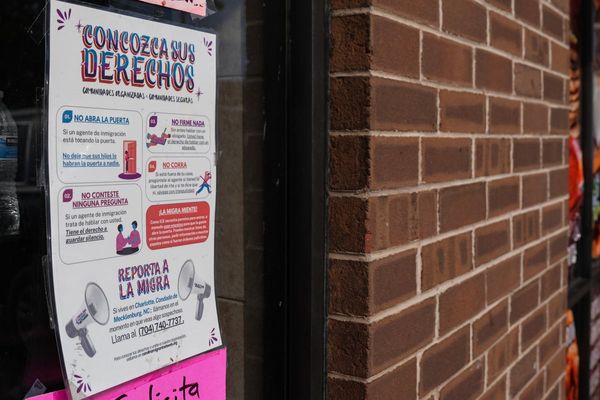
Horror is inherently a transgressive genre, with scares often achieved by taking the “safe” and rendering it “unsafe.”
It makes sense that one of the genre’s more successful perennial trends is specifically the transmogrification of childhood elements into sources of horror, from dangerous dolls (Child’s Play, Annabelle) and imaginary friends (Daniel Isn’t Real), to even mothers (The Babadook) and children themselves (Children of the Corn, Sinister). It’s no surprise that, given certain beloved children’s books are now in the public domain, we’re seeing these classic, heartwarming characters adapted into maniacal murdering monsters. Enter the horrific corruption of author A.A. Milne’s greatest creation in Rhys Frake-Waterfield’s Winnie-the-Pooh: Blood and Honey.
In the thick of the Hundred Acre Wood, Christopher Robin (played as an adult by Nikolai Leon) once befriended a set of cross-breed animal monstrosities — Owl, Rabbit, Eeyore, Piglet, and Winnie the Pooh. As the years passed, Christopher grew up and moved away, leaving his odd childhood friends behind. After abandonment and a slew of hardships, the creatures grew feral, turning on their own (poor Eyeore) and proceeding to terrorize unfortunate passers-by who enter the dangerous woods. Chrisopher Robin returns to introduce his betrothed to his strange childhood friends, and the reunion goes, to put it bluntly, poorly. Cut to Maria (Maria Taylor), whose five friends have the deep misfortune to be staying in a cabin in these particularly deadly woods.

Winnie the Pooh: Blood and Honey is an almost perfect set-up for a horror tale. Christopher Robin returns to his odd humanoid-animal childhood friends, which, as it turns out, was a bad idea. For fans of horror history, it’s a little nostalgic to see a return to the man-in-a-rubber-mask creature feature of yore, like 1958’s The Fly creating a classic creature with little more than a fly mask, a fake hand, and a dream. Unfortunately, Winnie the Pooh: Blood and Honey isn’t as good as the 1958 classic, but that doesn’t stop it from delivering the promise of at least some of the premise in the movie’s brief runtime.
It’s clear throughout that the movie’s a microbudget feature, but the “blood” of Blood and Honey is in ample supply: by and large the gore effects look good, and similarly the mask construction for Pooh and Piglet works. The masks are detailed and inhuman, and they move better than they should on the rare occasion the antagonists have to emote. It nonetheless still looks like two large individuals in masks rather than full-fledged hybridic monstrosities, but the masks’ off-kilter visage actually works in the movie’s favor, for the most part. The real pitfall for the creatures’ designs, however, lies in the fact that nothing else was done to make them seem inhuman. They’re a pair of baddies that wear clothes and use human weapons and cars, lumbering about murdering people; it’s a real disappointment that, bad or not, the film is so close to delivering memorable monsters but still lazily refuses to commit to the attempt.
The film’s script makes some notably curious choices, first and foremost in its structure. We start and end with Chrisopher Robin, the very same Christopher Robin who is ever-present in the film’s backstory, trailer, and official marketing, but the bulk of the movie involves the introduction and rapid destruction of these five friends before Christopher is set free and returns at the tail end. At the same time, few of those poor characters are given memorable attributes or enough focus to become full-fledged characters instead of fodder. Christopher has no connection to these women — their wildly separate stories making the movie feel like two films duct-taped together. The script is also full of a variety of dialogue that inches close to memorably bad camp but, yet again, stops short. Christopher “I think something’s wrong with Piglet! He just killed my wife!” Robin comes off with the most memorable dialogue, but it’s still far too little and often cut with pacing issues that permeate the rest of the movie as well.

While the film’s music works well, the overall sound mix is a bit of a mess. At times the music drowns out dialogue, other moments have no score but the dialogue is mumbled or too low to clearly make out. For example, there’s a particular moment where a character’s rescued and seems to be giving important reveals about the antagonists, and it’s exceedingly hard to hear a single word of her dialogue. Some of the dialogue also has a ‘very roomy’ sound to it, with dialogue seeming remarkably distant, and the overall SFX have a few of your usual horror sounds — squishes and splats and slices, etc. — but they often sound isolated without the cavalcade of environmental sound that add to a film’s realism.
Winnie the Pooh: Blood and Honey had real potential even at its lower budget. Some of its priorities, like making sure the masks were unsettling and making sure the gore worked (and it did!) were excellent choices. Some of the lead actors were really committing to strong emotional performances, but were undone by odd pacing, poorly timed cuts, or dialogue that needed just a little more attention. Most of Blood and Honey’s faults do seem salvageable with a little more care and attention and, in fact, could be improved cheaply with a little more time layering sound effects, honing the cut, rethinking shot framing, or designing the antagonists to feel more like inhuman hybrids and less like Rob Zombie’s Michael Myers in an otherwise cool pig mask. At the end, it’s just not Hundred Acre Good.
Winnie the Pooh: Blood and Honey is playing in theaters now.







